#Pelagornithidae
Text

Branching out a bit more into the Cenozoic featuring Pelagornis, possibly the largest flying bird.
Always been a huge fan of it's unique beak.
#my art#paleoart#sciart#pelagornis#pelagornithidae#pseudotooth bird#cenozoic#bird#aves#extinct#seabird#nature
202 notes
·
View notes
Text

#paleoblr#palaeoblr#paleontology#palaeontology#bird#birds#ichthyornis#pelagornis#pelagornithidae#dinosaur#dinosaurs#diagram
39 notes
·
View notes
Text
The rhamphotheca of the Eocene pseudo-toothed birds from Antarctica
Published 7th July
A study comparing extinct Pelagornithidae and extant relatives to reconstruct the beak structure of Eocene pseudo-toothed birds.

Source:
6 notes
·
View notes
Photo

Weird Heads Month #29: Giant Saw-Toothed Birds
The pelagornithids, or "pseudotooth birds", were a group of large seabirds that were found around the world for almost the entire Cenozoic, existing for at least 60 million years and only going completely extinct just 2.5 million years ago.
Their evolutionary relationships are uncertain and in the past they've been considered as relatives of pelicaniformes, albatrosses and petrels, or storks, but more recently they've been proposed to have been closer related to ducks and geese instead.
Whatever they were, they were some of the largest birds to ever fly, and many of the "smaller" species still had wingspans comparable to the largest modern flying birds.
But their most notable feature was their beaks. Although at first glance they look like they were lined with pointy teeth, these structures were actually outgrowths of their jaw bones covered with keratinous beak tissue. While these bony spikes would have been useful for holding onto slippery aquatic animals like fish and squid, they were actually hollow and relatively fragile so pelagornithids must have mainly caught smaller prey that couldn't thrash around hard enough to break anything.
The serrations also only developed towards full maturity, and the "toothless" juveniles may have had a completely different ecology to adults.
Pelagornis chilensis here was one of the larger species of pelagornithid, with a wingspan of 5-6m (16'4"-19'8"), known from the western and northern coasts of South America during the late Miocene about 11-5 million years ago.
Like other pelagornithids it was highly adapted for albatross-like dynamic soaring, with long narrow wings that allowed it to travel huge distances while expending very little energy – but with its proportionally short legs it would have been clumsy on the ground and probably spent the vast majority of its life on the wing, only returning to land to breed.

———
Nix Illustration | Tumblr | Pillowfort | Twitter | Patreon
#weird heads 2020#science illustration#paleontology#paleoart#palaeoblr#pelagornis#pelagornithidae#pseudotooth bird#odontopterygiformes#galloanserae#bird#dinosaur#art#an odd duck#maybe#it's a lovely morning in the miocene and you are a horrible pelagornithid#deliberately visually emphasizing the duckishness because i haven't seen anyone actually do that with these guys
142 notes
·
View notes
Text
Pelagornis
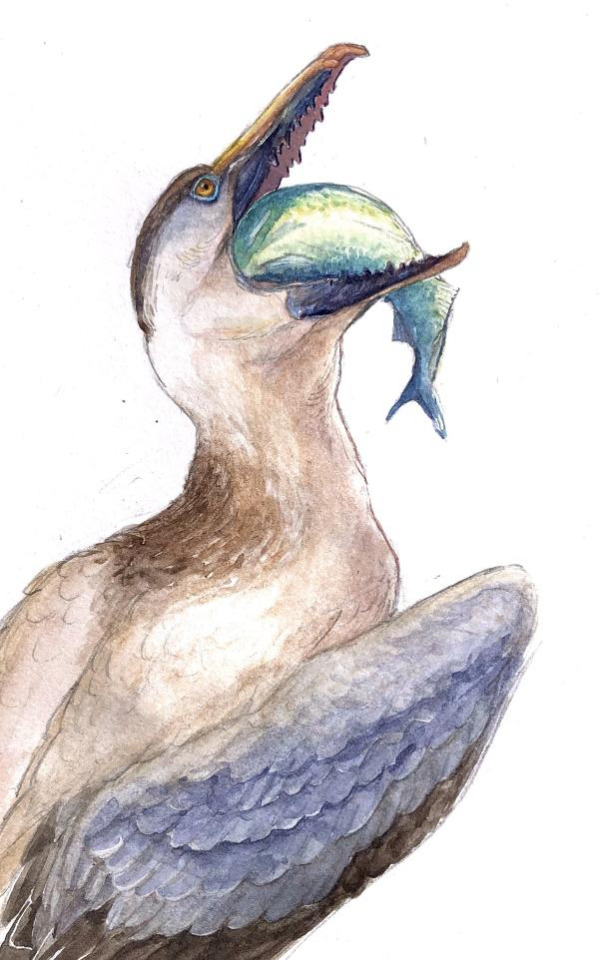
By Ripley Cook
Etymology: Sea Bird
First Described By: Lartet, 1857
Classification: Dinosauromorpha, Dinosauriformes, Dracohors, Dinosauria, Saurischia, Eusaurischia, Theropoda, Neotheropoda, Averostra, Tetanurae, Orionides, Avetheropoda, Coelurosauria, Tyrannoraptora, Maniraptoromorpha, Maniraptoriformes, Maniraptora, Pennaraptora, Paraves, Eumaniraptora, Averaptora, Avialae, Euavialae, Avebrevicauda, Pygostaylia, Ornithothoraces, Euornithes, Ornithuromorpha, Ornithurae, Neornithes, Neognathae, Pelagornithidae
Referred Species: P. chilensis, P. longirostris, P. mauretanicus, P. miocaenus, P. orri, P. sandersi, P. stirtoni, P. tenuirostris, P. wetmorei
Status: Extinct
Time and Place: Between 30 and 2.5 million years ago, from the Rupelian of the Oligocene through the beginning of the Pleistocene (in the Gelasian age)


Pelagornis, being an extremely common seabird, is known from nearly everywhere around the world, usually associated with the coast.
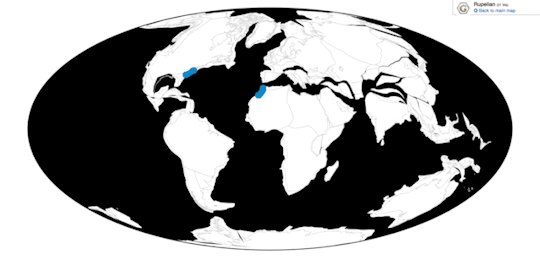
Physical Description: Despite the incredibly generic name, Pelagornis was quite an interesting bird. Like other pseudotooth birds, both its upper and lower beak bore toothlike spikes, in an alternating small/big/small/big pattern. Its beak was robust and fairly long compared to the back of the skull. These pseudoteeth appear to have grown in relatively late in Pelagornis’s growth, implying the keratin covering the beak may not have been fully hardened until close to adulthood. Interestingly enough, fossil evidence indicates that Pelagornis probably held its head upright at a vertical angle.
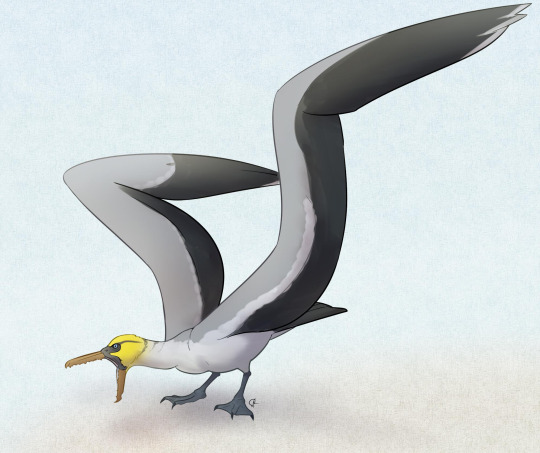
By José Carlos Cortés
Pelagornis was fucking huge, m’kay. P. sandersi has an estimated wingspan between 6.1 and 7.4 meters! This makes Pelagornis the bird with the largest wingspan (but not the heaviest flying bird - that record belongs to Argentavis). Its wings were even more proportionally long and narrow than those of the largest flying birds alive today, the albatrosses. In comparison, its body was fairly small. There were, of course, some species of Pelagornis that were smaller than this, reaching only 4 meters long in terms of wingspan. Still, this large wingspan size is really only characteristic of these birds in flight - compressed, they would have looked much smaller, especially given that they were very light weight. They had stout legs and shorter tails, which indicates that they weren’t very good walkers, and spent most of their time in the air or sitting on the land.
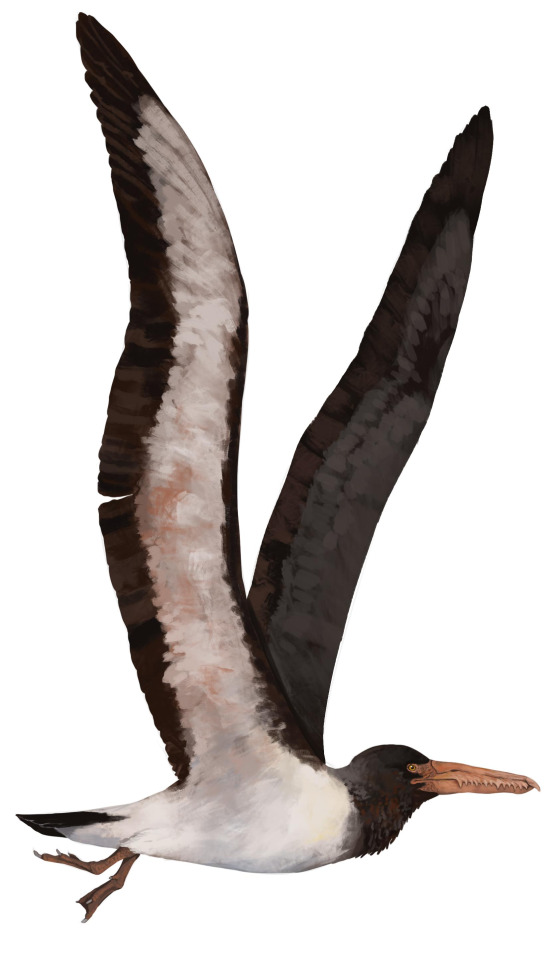
By Jack Wood
Diet: Probably fish. The pseudoteeth are likely an adaptation to grab and hold onto large fish. Similar toothlike serrations are seen, albeit much less exaggerated, in modern mergansers, which also eat fish. In addition, the vertical position of the head would have allowed Pelagornis to skim-feed, grabbing fish and other aquatic organisms from the top layer of the ocean and scooping them into their mouths. Thus, the fake-teeth would have allowed Pelagornis to grab onto fish better than non-toothed skim feeding birds. It may have also used these sharp fake teeth in order to grab onto the slipperiest fish and cephalopods - rather than harder shelly animals.

By Scott Reid
Behavior: As with modern seabirds, Pelagornis likely spent most of its time out at sea. Gliding on oceanic thermals would have helped to support its huge body in the air without wasting energy just to stay aloft - which was important, since it wasn’t very good at flapping its wings and would have had trouble staying aloft long enough to get food if it had to flap too frequently. Think an albatross, but a giant, evil albatross. Landing and taking off would have been more awkward, though. It probably needed to take advantage of headwinds, drops in elevation and/or air gusts to get into the air at all. Albatrosses also kinda have this problem, but nowhere near to the same extent. The late appearance of the pseudoteeth implies that Pelagornis may have fed its young back on land like many modern seabirds before they could feed themselves out at sea. As such, they would have sought out good nesting sites, which may correspond to where fossils of Pelagornis are found - indicating that their spread around the world was greater than that we know of. Since it was a sea bird, it probably would have been very social, living in large colonies - and it would have cared for its young in similar social groups. In fact, it seems more likely than not that it would have laid its nests on cliffs and in rocky areas and plateaus, where being able to take off would have been easier than flatter, sandier beaches. Whether or not these animals were as noisy as modern seabirds is really another question altogether.

By Jack Wood
Interestingly enough, Pelagornis had a salt gland in the eye that would have allowed it to excrete excess salt, which was an extremely helpful trait when Pelagornis ate almost entirely seafood. That seafood diet didn’t meant it wasn’t a danger, however - today, seabirds will venture away from the coasts in order to scavenge food on the beach, and they are certainly defensive of their nests, young, and territory. Also fascinatingly, it had a very very very long skull - with all of those pseudoteeth packed in - which had similar shapes and organization as to the extinct really toothed birds of the Mesozoic. This implies that there was a certain amount of evolutionary regression in Pelagornis, allowing it to better support its teeth and chomping ability than it would otherwise. There is also an interesting furrow in the skull, which allowed it to be better support the head and possibly to better grab prey in the ocean.
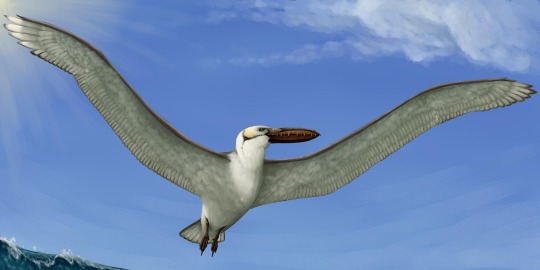
By Scott Reid
Ecosystem: Pelagornis lived around coastlines worldwide. Because of this, it is difficult to pinpoint with certainty the types of animals it lived with. In fact, it was so long-lived and widespread it is more likely than not that Pelgaornis interacted with any ocean-going creature or animal found along the coast. It doesn’t seem to have a preference in the fossil record between rocky coasts or beaches, though it did seem to stay in at least somewhat warmer ecosystems and where cliffs would have been present for easier take-offs (and it is reasonable to suppose that cliff areas would have been its preferred place for nesting). Some notable animals it would have interacted with include extinct penguins, cetaceans, the famed giant shark Megalodon and… humans. Yup, Pelagornis is known from locations where early members of genus Homo ventured to. So, if you can imagine being afraid of a giant bird with fake teeth a little too well, that would be the instincts of your ancestors talking.

By Scott Reid
Other: Pelagornis is a fun time, classification wise, for multiple reasons: one, a whole bunch of different types of Pseudotoothed birds are actually, apparently, species of Pelagornis; and two, we don’t really know what Pseudotoothed birds really are. So, let’s break this down into those two parts. What’s going on with the species? Well, in the 2010s, a lot of research has been made that shows a bunch of the Neogene Pseudotoothed birds that we’ve counted as different genera are actually… just… part of Pelagornis. Why Wikipedia has not chosen to update their information as to this effect is beyond me, but the fact remains is that a lot of Pseudotoothed birds are just different shades of Pelagornis, primarily due to the fact that they really… aren’t different. In fact, a lot of the differences were just based on time and place, and the fact that Pseudotoothed birds weren’t really well known at all. The loss of Osteodontornis is a bit of a bummer, but there aren’t any major differences between this genus and Pelagornis, so it’s gone. We’ve also lost Pseudodontornis, you know, the name that actually means “fake toothed bird”, unlike the crappy name for Pelagornis, which just means Sea Bird. Like, come on people. Why are we here. Just to suffer. We’ve also lost Palaeochenoides, Neodontornis, and Tympanonesiotes. Hence the extreme amount of art in this article - the last time I covered Pseudotoothed birds, these were separate. So we have an abundance of terrifying tooth art.

By José Carlos Cortés
Finally - what the heck are Pseudotoothed birds? We don’t know. We really don’t know where they go. Are they related to the sea birds we have today (the Aequorlitornithes)? Are they related to ducks? Are they something else entirely? We have no idea, because, frankly, they seem to just appear in the fossil record without any sort of origin whatsoever. Like magic. Suddenly, toothed birds were back like the asteroid never hit. Honestly if I were to hazard a guess, based on the fossil characteristics, they’re probably none of the above - but an early branching group of Neognathous (aka, all birds that aren’t ratites and their cousins) birds that evolved from a non-easily fossilized ancestor. Whether that ancestor had weak bones or just lived in places where fossils don’t happen is a different question entirely, but either way, so far we have nothing. They just appear, in the Paleocene, out of nowhere. And, eventually, Pelagornis also disappeared.

By Jack Wood
Why did Pelagornis, the latest surviving species disappear? The most likely answer is climate change. The onset of the ice age would have caused extreme changes to the water patterns, currents, and air flow. Since Pelagornis didn’t flap its wings much, and relied almost entirely on soaring and thermals, it probably would have been greatly affected by changes in these weather patterns. So, changes in the ocean and the air by the ice age would have decreased its ability to reach food, and then the dramatic changes in its home climate would have been a further death knell. Interestingly enough, they only began to become uncommon right before they became extinct - indicating that Pelagornis really was finished off by this change in climate. Which is sad, because that’s right around when humans were becoming more of a thing, and it would have been nice to see one of these things in life. Except it wouldn’t have been. Because they’re terrifying. But I laugh in the face of danger. I think. I dunno I just think they’re neat.
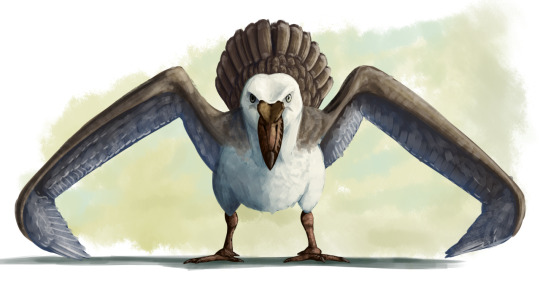
By Scott Reid
Species Differences: The different species of Pelagornis differ primarily due to location and time, though there are some differences in shape and size - those fossils that were once assigned to Tympanonesiotes, for example, were on average smaller than other members of this genus. The largest known species was decidedly Pelagornis sandersi, though the best known species is Pelagornis chilensis. For now, however, Pelagornis is kind of a mess, since so much research is needed on this species complex to make sure things are where they belong and one genus is enough, so species differences are difficult to parse out until more research has been published on the subject. Just know that there were a lot of Pelagornis - and they came in all kinds of different shapes and sizes all over the place.
~ By Meig Dickson and Henry Thomas
Sources Under the Cut
Becker, J.J. (1987): Neogene avian localities of North America. Smithsonian Research Monographs 1. Prentice Hall & IBD.
Bourdon, Estelle (2005): Osteological evidence for sister group relationship between pseudo-toothed birds (Aves: Odontopterygiformes) and waterfowls (Anseriformes). Naturwissenschaften 92(12): 586–591.
Brodkorb, Pierce (1963): Catalogue of fossil birds. Part 1 (Archaeopterygiformes through Ardeiformes). Bulletin of the Florida State Museum, Biological Sciences 7(4): 179–293.
Cenizo, M., C. Acosta Hospitaleche, and M. Reguero. 2016. Diversity of pseudo-toothed birds (Pelagornithidae) from the Eocene of Antarctica. Journal of Paleontology 89 (5): 870 - 881.
Hastings, A. K., and A. C. Dooley. 2017. Fossil-collecting from the middle Miocene Carmel Church Quarry marine ecosystem in Caroline County, Virginia. The Geological Society of America Field Guide 47:77-88
Hopson, James A. (1964): Pseudodontornis and other large marine birds from the Miocene of South Carolina. Postilla 83: 1–19.
Ksepka, D.T. 2014. Flight performance of the largest volant bird. PNAS 111: 10624-10629.
Louchart, A., Sire, J.-Y., Mourer-Chauvire, C., Geraads, d., viriot, L., de Buffrenil, V. 2013. Structure and Growth Pattern of Pseudoteeth in Pelagornis mauretanicus (Aves, Odontopterygiformes, Pelagornithidae). PLoS One 8(11): e80372.
Mayr, G. 2009. Paleogene Fossil Birds. Springer-Verlag Berlin Heidelberg.
Mayr, G., D. Rubilar-Rogers. 2010. Osteology of a new giant bony-toothed bird from the Miocene of Chile, with a revision of the taxonomy of Neogene Pelagornithidae. Journal of Vertebrate Paleontology 30 (5): 1313-1330.
Mayr, G., J. L. Goedert, S. A. McLeod. 2013. Partial Skeleton of a Bony-Toothed Bird from the Late Oligocene/Early Miocene of Oregon (USA) and the Systematics of Neogene Pelagornithidae. Journal of Paleontology 87 (5): 922 - 929.
Mayr, G. 2017. Avian Evolution: The Fossil Record of Birds and its Paleobiological Significance. Topics in Paleobiology, Wiley Blackwell. West Sussex.
McKee, Joseph W.A. (1985). "A pseudodontorn (Pelecaniformes: Pelagornithidae) from the middle Pliocene of Hawera, Taranaki, New Zealand". New Zealand Journal of Zoology. 12 (2): 181–184.
Mlíkovský, Jirí (2002): Cenozoic Birds of the World, Part 1: Europe. Ninox Press, Prague.
Olson, Storrs L. (1985): The Fossil Record of Birds. In: Farner, D.S.; King, J.R. & Parkes, Kenneth C. (eds.): Avian Biology 8: 79-252.
Ono, Keiichi (1989). "A Bony-Toothed Bird from the Middle Miocene, Chichibu Basin, Japan". Bulletin of the National Science Museum Series C: Geology & Paleontology. 15 (1): 33–38.
Rincón R., Ascanio D. & Stucchi, Marcelo (2003). "Primer registro de la familia Pelagornithidae (Aves: Pelecaniformes) para Venezuela [First record of Pelagornithidae family from Venezuela]" (PDF). Boletín de la Sociedad Venezolana de Espeleología (in Spanish and English). 37: 27–30.
Scarlett, R.J. (1972): Bone of a presumed odontopterygian bird from the Miocene of New Zealand. New Zealand Journal of Geology and Geophysics 15(2): 269-274.
Zouhri, S., P. Gingerich, S. Adnet, E. Bourdon, S. Jouve, B. Khalloufi, A. Amane, N. Elboudali, J.-C. Rage, F. Lapparent De Broin, A. Kaoukaya and S. Sebti. 2018. Middle Eocene vertebrates from the sabkha of Gueran, Atlantic coastal basin, Saharan Morocco, and their peri-African correlations. Comptes Rendus Geoscience 350(6):310-318
#Pelagornis#Pseudotoothed bird#Pelagornithid#Bird#Dinosaur#Birds#Dinosaurs#Factfile#Birblr#Palaeoblr#Neogene#Quaternary#Paleogene#North America#South America#Eurasia#Australia & Oceania#Africa#Piscivore#Water Wednesday#Neognath#Osteodontornis#Pseudodontornis#paleontology#prehistory#prehistoric life#biology#a dinosaur a day#a-dinosaur-a-day#dinosaur of the day
287 notes
·
View notes
Text
Un uccello marino dalla dentatura ossea visse in Nuova Zelanda 62 milioni di anni fa
Un uccello marino dalla dentatura ossea visse in Nuova Zelanda 62 milioni di anni fa

Soprannominato Protodontopteryx ruthae, l’antico uccello marino appartiene ai Pelagornithidae, un’antica famiglia di uccelli dai denti ossei.
Questi uccelli marini erano precedentemente conosciuti dal tardo Paleocene ai siti fossili del Pliocene e alcune specie hanno raggiunto un’apertura alare fino a 6,4 m.
Il protodontopteryx ruthae è il membro più antico, ma più piccolo della famiglia.
Aveva…
View On WordPress
0 notes
Text
Bony Toothed Seabird Lived In New Zealand
Bony Toothed Seabird Lived In New Zealand
Bony Toothed Seabird Lived In New Zealand 62 Million Years Ago, Paleontologists Have Found The Remains Of A Bony Toothed Seabird. Paleontologists have found the remains of a pelgornitid bird that lived in New Zealand 62 million years ago (early Paleocene age). Nicknamed Protodontoproteix ruthe, it belongs to the ancient seabird Pelagornithidae, an ancient family of Bony Toothed Seabirds.
Previous…
View On WordPress
0 notes
Photo

I commissioned Apsaravis, one of my favorite paleoartists, to create a Pelagornis feeding scenario. What is not to love about this? She is open for commissions. [ Tumblr | DeviantART ]
I also just learned that scientists described a new member of the genus: Pelagornis sandersi. It had a 20-24 foot wingspan!
546 notes
·
View notes
Photo

A skeleton of the late Cenozoic "pseudotooth bird", Pelagornis. As the name would imply, what you see in its mouth aren't true teeth, but protrustions of its beak. Pelagornis itself could attain a wingspan in excess of 15 feet (approx. 3 meters), but even "small" pelagornithids were particularly big for flying birds. These birds went extinct in the Pleistocene, but for much of the Cenozoic they might well have taken up the ecological niche left empty by some pterosaur groups at their extinction 66 million years ago.
#Archosaurofiles#Pelagornis#Pelagornithidae#Galloanserae#Birds#Maniraptorans#Coelurosaurs#Theropods#Dinosaurs
9 notes
·
View notes
Text
Osteodontornis orri

By Scott Reid on @drawingwithdinosaurs
PLEASE SUPPORT US ON PATREON. EACH and EVERY DONATION helps to keep this blog running! Any amount, even ONE DOLLAR is APPRECIATED! IF YOU ENJOY THIS CONTENT, please CONSIDER DONATING!
Name: Osteodontornis orri
Status: Extinct
First Described: 1957
Described By: Howard
Classification: Dinosauria, Theropoda, Neotheropoda, Averostra, Tetanurae, Orionides, Avetheropoda, Coelurosauria, Tyrannoraptora, Maniraptoriformes, Maniraptora, Pennaraptora, Paraves, Eumaniraptora, Averaptora, Avialae, Euavialae, Avebrevicauda, Pygostylia, Ornithothoraces, Euornithes, Ornithuromorpha, Ornithurae, Neornithes, Neognathae, Pelagornithidae
Hey guys! We have a decently known Pelagornithid! Hooray! Osteodontornis is a Pelagornithid from a variety of locations of the Miocene of the North Pacific - it’s known from the Claredonian Shale of California, the Barstovian Round Mountain Silt (also of California), the Monterey Formation of California, the Nagura Formation of Japan, the Oi Formation of Japan, and the Mizunami Group also in Japan. There are also fossils known from the Nye Formation of Oregon, and the Astoria Formation of Oregon. The Capadare Formation of Venezuela and the Pisco Formation of Peru also have fossils of Osteodontornis. This indicates that the entire Pacific Ocean probably saw this bird, and that it was a very common sight in the latter part of the Cenozoic era. Osteodontornis probably just lived from about 20 million years ago to 6 million years ago, from the Burdigalian to the Messinian of the Miocene of the Neogene.

By Jack Wood on @thewoodparable
Osteodontornis had a wingspan of about 5.5 to 6 meters and it was about 1.2 meters tall when standing, giving it one of the largest wingspans of any bird known, along with other Pelagornithids. It had a very long head with a long, “toothed” beak, allowing for it to probe the water for squid and other sources of food. It had very lightweight bones to aid it in lifting itself over large distances. Osteodontornis was also just a rather lightweight Pseudotoothed Bird, slender compared to its relatives. It probably built nests on high plateaus and cliffs where it would spread its wings to take off, and its teeth were ideal for digging into and holding slippery prey in the water.
Source:
https://en.wikipedia.org/wiki/Osteodontornis
#osteodontornis#osteodontornis orri#bird#dinosaur#pseudotoothed bird#birblr#palaeoblr#dinosaurs#paleontology#prehistory#prehistoric life#biology#a dinosaur a day#a-dinosaur-a-day#dinosaur of the day#dinosaur-of-the-day#science#nature#factfile#Dìneasar#דינוזאור#डायनासोर#ديناصور#dínosaurio#risaeðla#ڈایناسور#deinosor#恐龍恐龙#динозавр#dinosaurio
88 notes
·
View notes
Text
Macrodontopteryx oweni

By Scott Reid on @drawingwithdinosaurs
PLEASE SUPPORT US ON PATREON. EACH and EVERY DONATION helps to keep this blog running! Any amount, even ONE DOLLAR is APPRECIATED! IF YOU ENJOY THIS CONTENT, please CONSIDER DONATING!
Name: Macrodontopteryx oweni
Status: Extinct
First Described: 1976
Described By: Harrison & C. A. Walker
Classification: Dinosauria, Theropoda, Neotheropoda, Averostra, Tetanurae, Orionides, Avetheropoda, Coelurosauria, Tyrannoraptora, Maniraptoriformes, Maniraptora, Pennaraptora, Paraves, Eumaniraptora, Averaptora, Avialae, Euavialae, Avebrevicauda, Pygostylia, Ornithothoraces, Euornithes, Ornithuromorpha, Ornithurae, Neornithes, Neognathae, Pelagornithidae
Macrodontopteryx is a Pseudotoothed bird from the London Clay Formation of England, distinct from yesterday’s Dasornis, though originally it was thought to be a member of that genus. It lived about 55 to 50 million years ago, in the Ypresian age of the Eocene of the Paleogene. It is known from a crushed skull with most of the beak missing, so it’s difficult to say much about the genus, though it probably would have had a wingspan of about 4 meters in length, making it fairly average in size. It may have other remains from as late as the Oligocene as well.
Source:
https://en.wikipedia.org/wiki/Macrodontopteryx
#macrodontopteryx#macrodontopteryx oweni#bird#dinosaur#pseudotoothed bird#palaeoblr#birblr#dinosaurs#paleontology#prehistory#prehistoric life#biology#a dinosaur a day#a-dinosaur-a-day#dinosaur of the day#dinosaur-of-the-day#science#nature#factfile#Dìneasar#דינוזאור#डायनासोर#ديناصور#dínosaurio#risaeðla#ڈایناسور#deinosor#恐龍恐龙#динозавр#dinosaurio
97 notes
·
View notes
Text
Asiavis phosphatica

By Ripley Cook on @iguanodont
PLEASE SUPPORT US ON PATREON. EACH and EVERY DONATION helps to keep this blog running! Any amount, even ONE DOLLAR is APPRECIATED! IF YOU ENJOY THIS CONTENT, please CONSIDER DONATING!
Name: Asiavis phosphatica
Status: Extinct
First Described: 1986
Described By: Nessov
Classification: Dinosauria, Saurischia, Eusaurischia, Theropoda, Neotheropoda, Averostra, Tetanurae, Orionides, Avetheropoda, Coelurosauria, Tyrannoraptora, Maniraptoriformes, Maniraptora, Pennaraptora, Paraves, Eumaniraptora, Averaptora, Avialae, Euavialae, Avebrevicauda, Pygostylia, Ornithothoraces, Euornithes, Ornithuromorpha, Ornithurae, Neornithes, Neognathae, Galloanserae, Anseriformes, Anseres, Anatoidea, Anatidae
Sometimes, fossil birds are extraordinary, well preserved, and well studied animals that give us a picture of how dinosaurs evolved after the end-Cretaceous extinction, true blessings that complete our understanding of this wonderful group of animals. This is not one of those times. Asiavis is another Nessov taxon, one of many birds named by a truly terrible Russian paleontologist during the 1980s that haven’t been refuted and, as such, I have to talk about it. It is known from the Kyzulkum Desert in Uzbekistan, dating probably to the Middle Eocene, somewhere between 47 and 38 million years ago, from the Lutetian to the Bartonian. Originally thought to be a relative of cranes and crakes, it’s now thought to be a very primitive goose, though of course, without better remains that’s difficult to determine exactly. If it is, that would make it one of the oldest known proper “geese”.
Sources:
Mayr, G., E. Zvonok. 2011. Middle Eocene Pelagornithidae and Gaviiformes (Aves) from the Ukrainian Paratethys. Palaeontology 54(6): 1347 - 1359.
Nessov, L. A. 1986. Pervaya nakhodka pozdnemelovoy ptitsy-ikhtiornisa v starom svete i nekotorye drugie kosti ptits iz Mela i Paleogena spedney Azii [The first record of the Late Cretaceous bird Ichthyornis in the Old World and some other bird bones from the Cretaceous and Paleogene of Central Asia]. Trudy Zoologicheskogo Instituta Akademiy Nauk SSSR 147:31-38
Panteleyev A.V. 1999. The systematic position of the Eocene bird Asiavis phosphatica // Zoosystematica Rossica. 8 (2): 351-352.
https://en.wikipedia.org/wiki/Anseriformes
https://en.wikipedia.org/wiki/1986_in_paleontology
#asiavis#asiavis phosphatica#bird#dinosaur#duck#palaeoblr#birblr#dinosaurs#paleontology#prehistory#prehistoric life#biology#a dinosaur a day#a-dinosaur-a-day#dinosaur of the day#dinosaur-of-the-day#science#nature#factfile#Dìneasar#דינוזאור#डायनासोर#ديناصور#dínosaurio#risaeðla#ڈایناسور#deinosor#恐龍恐龙#динозавр#dinosaurio
38 notes
·
View notes
Text
Lutetodontopteryx tethyensis

By Jack Wood on @thewoodparable
PLEASE SUPPORT US ON PATREON. EACH and EVERY DONATION helps to keep this blog running! Any amount, even ONE DOLLAR is APPRECIATED! IF YOU ENJOY THIS CONTENT, please CONSIDER DONATING!
Name: Lutetodontopteryx tethyensis
Status: Extinct
First Described: 2012
Described By: Mayr & Zvonok
Classification: Dinosauria, Theropoda, Neotheropoda, Averostra, Tetanurae, Orionides, Avetheropoda, Coelurosauria, Tyrannoraptora, Maniraptoriformes, Maniraptora, Pennaraptora, Paraves, Eumaniraptora, Averaptora, Avialae, Euavialae, Avebrevicauda, Pygostylia, Ornithothoraces, Euornithes, Ornithuromorpha, Ornithurae, Neornithes, Neognathae, Pelagornithidae
Guest post by @raptorcivilization!
Lutetodontopteryx is a Pelagornithid known from the Ikovo sand quarry in eastern Ukraine, found in near-shore sediments dating to the middle Eocene (early Lutetian age), roughly 48 million years ago. Despite being so early, it’s thought to be the closest relative of later, larger Neogene Pelagornithids. Originally thought to be a specimen of Dasornis/Odontopteryx, the fossil was described and named only in 2012. It’s a fairly small Pelagornithid. A good portion of the skeleton is represented, including the characteristic pseudotoothed beak. The pseudoteeth are long, narrow, and backward-curved. The form of the pseudoteeth implies that Pelagornithid pseudoteeth might be homologous on some molecular level to actual teeth. Well then. It lived alongside the early loon Colymbiculus and a much larger Pelagornithid which resembles Gigantornis.
Source:
Mayr, G., Zvonok, E. 2012. A new genus and species of Pelagornithidae with well-preserved pseudodentition and further avian remains from the middle Eocene of the Ukraine. Journal of Vertebrate Paleontology 32(4): 914-925.
#lutetodontopteryx#lutetodontopteryx tethyensis#pseudotoothed bird#bird#dinosaur#birblr#palaeoblr#dinosaurs#paleontology#prehistory#prehistoric life#biology#a dinosaur a day#a-dinosaur-a-day#dinosaur of the day#dinosaur-of-the-day#science#nature#factfile#Dìneasar#דינוזאור#डायनासोर#ديناصور#dínosaurio#risaeðla#ڈایناسور#deinosor#恐龍恐龙#динозавр#dinosaurio
53 notes
·
View notes
Text
Aequornis traversei

By Jack Wood on @thewoodparable
PLEASE SUPPORT US ON PATREON. EACH and EVERY DONATION helps to keep this blog running! Any amount, even ONE DOLLAR is APPRECIATED! IF YOU ENJOY THIS CONTENT, please CONSIDER DONATING!
Name: Aequornis traversei
Status: Extinct
First Described: 2006
Described By: Bourdon
Classification: Dinosauria, Theropoda, Neotheropoda, Averostra, Tetanurae, Orionides, Avetheropoda, Coelurosauria, Tyrannoraptora, Maniraptoriformes, Maniraptora, Pennaraptora, Paraves, Eumaniraptora, Averaptora, Avialae, Euavialae, Avebrevicauda, Pygostylia, Ornithothoraces, Euornithes, Ornithuromorpha, Ornithurae, Neornithes, Neognathae, Pelagornithidae
Aequornis is a very poorly known genus of Pseudotoothed bird, from the Kpogamé-Hahotoé Formation of the Togolese Republic, living sometime between 48 and 40 million years ago in the Lutetian of the Eocene of the Paleogene. As it was named in a thesis, very little about this dinosaur is known beyond that, though presumably it would have been a seagoing bird.
Sources:
https://en.wikipedia.org/wiki/Pelagornithidae
#aequornis#aequornis traversei#bird#dinosaur#pseudotoothed bird#birblr#palaeoblr#dinosaurs#paleontology#prehistory#prehistoric life#biology#a dinosaur a day#a-dinosaur-a-day#dinosaur of the day#dinosaur-of-the-day#science#nature#factfile#Dìneasar#דינוזאור#डायनासोर#ديناصور#dínosaurio#risaeðla#ڈایناسور#deinosor#恐龍恐龙#динозавр#dinosaurio
46 notes
·
View notes
Text
“Odontoptila” inexpectata

By José Carlos Cortés on @quetzalcuetzpalin-art
PLEASE SUPPORT US ON PATREON. EACH and EVERY DONATION helps to keep this blog running! Any amount, even ONE DOLLAR is APPRECIATED! IF YOU ENJOY THIS CONTENT, please CONSIDER DONATING!
Name: “Odontoptila” inexpectata
Status: Extinct
First Described: 2005
Described By: Bourdon
Classification: Dinosauria, Theropoda, Neotheropoda, Averostra, Tetanurae, Orionides, Avetheropoda, Coelurosauria, Tyrannoraptora, Maniraptoriformes, Maniraptora, Pennaraptora, Paraves, Eumaniraptora, Averaptora, Avialae, Euavialae, Avebrevicauda, Pygostylia, Ornithothoraces, Euornithes, Ornithuromorpha, Ornithurae, Neornithes, Neognathae, Pelagornithidae
“Odontoptila” inexpectata is one of those fun genera that actually is the name for an insect (this time, a moth) and the vertebrate paleontologist describing dinosaur bones didn’t actually know, so they used the name anyway and now we just have to sit here, waiting, for someone to redescribe the fossils. Yay! “Odontoptila” itself is from the Ouled Abdoun Basin of Morocco, living on the Paleocene Eocene boundary - so about 56 million years ago, from the Thanetian to the Ypresian, all in the Paleogene. This makes it one of the oldest known Pseudotoothed birds. In addition to this, it is also the smallest one known - only about the size of a white-chinned petrel, making it a very cute Demon Bird.
Source:
https://en.wikipedia.org/wiki/Pelagornithidae
#odontoptila#odontoptila inexpectata#bird#dinosaur#pseudotoothed bird#birblr#palaeoblr#paleontology#prehistory#prehistoric life#dinosaurs#biology#a dinosaur a day#a-dinosaur-a-day#dinosaur of the day#dinosaur-of-the-day#science#nature#factfile#Dìneasar#דינוזאור#डायनासोर#ديناصور#ডাইনোসর#risaeðla#ڈایناسور#deinosor#恐龍#恐龙#динозавр
46 notes
·
View notes
Text
Palaeochenoides mioceanus

By José Carlos Cortés on @quetzalcuetzpalin-art
PLEASE SUPPORT US ON PATREON. EACH and EVERY DONATION helps to keep this blog running! Any amount, even ONE DOLLAR is APPRECIATED! IF YOU ENJOY THIS CONTENT, please CONSIDER DONATING!
Name: Palaeochenoides mioceanus
Status: Extinct
First Described: 1916
Described By: Shufeldt
Classification: Dinosauria, Theropoda, Neotheropoda, Averostra, Tetanurae, Orionides, Avetheropoda, Coelurosauria, Tyrannoraptora, Maniraptoriformes, Maniraptora, Pennaraptora, Paraves, Eumaniraptora, Averaptora, Avialae, Euavialae, Avebrevicauda, Pygostylia, Ornithothoraces, Euornithes, Ornithuromorpha, Ornithurae, Neornithes, Neognathae, Pelagornithidae
Palaeochenoides is a Pseudotoothed Bird from either the Cooper or Chandler Bridge Formation of South Carolina (the exact formation it belongs to is under debate), living about 23 to 27 million years ago, in the Chattian of the Oligocene of the Paleogene. It is known from very limited remains that have been in taxonomic limbo for many years, considered to be a giant goose or swan, then a pelican, then a tropicbird, and then some other sort of waterbird, before eventually finding its way to being a Pseudotoothed Bird. The remains are very poor and degraded at this point, but it probably was a larger Pseudotoothed bird, comparable in size to Osteodontornis. It is of course uncertain where Pseduoothed Birds themselves belong, but the jury is out on that one. Either way, Palaeochenoides was a oceangoing bird, preying on fish in the sea, and it actually lived alongside some early whales.
Source:
https://en.wikipedia.org/wiki/Palaeochenoides
https://en.wikipedia.org/wiki/Chandler_Bridge_Formation
#palaeochenoides#palaeochenoides mioceanus#bird#dinosaur#pseudotoothed bird#birblr#palaeoblr#dinosaurs#paleontology#prehistory#prehistoric life#biology#a dinosaur a day#a-dinosaur-a-day#dinosaur of the day#dinosaur-of-the-day#science#nature#factfile#Dìneasar#דינוזאור#डायनासोर#ديناصور#dínosaurio#risaeðla#ڈایناسور#deinosor#恐龍恐龙#динозавр#dinosaurio
39 notes
·
View notes